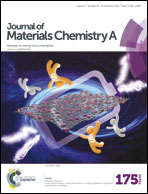Dual doping strategy enhanced the lithium storage properties of graphene oxide binary composites†
Abstract
Recently, binary composites as anode materials for lithium ion batteries have become prominent due to the synergistic effect of both individual electrodes. However, some of these binary composites, particularly with graphene, still suffer from low storage capacity with increasing current densities. To improve lithium storage performance of the binary composites, we used a SnO2 and graphene oxide binary composite, as an example, and double-doped with sulfur and fluorine. Compared with the bare SnO2@graphene oxide composite, the sulfur and fluorine co-doped SnO2@graphene oxide (SFSG) composite shows enhanced Li-ion storage and excellent cycling stability. The initial discharge capacity of the SFSG composite was up to 1419 mA h g−1 at 0.5 A g−1, showing a long-term stability and an outstanding rate capability at 3.2 A g−1. A full cell lithium ion battery assembled based on the SFSG anode also delivered high capacity along with high energy and power densities. The enhanced electrochemical performances of the SFSG composite were attributed to fluorine doping, which improved the stability and conductivity of the composite, and interfacial sulfur doping, which enhanced the rapid diffusion of lithium ions.


 Please wait while we load your content...
Please wait while we load your content...